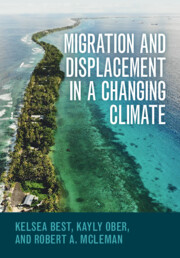Book contents
- Migration and Displacement in a Changing Climate
- Reviews
- Migration and Displacement in a Changing Climate
- Copyright page
- Contents
- Preface
- Acknowledgments
- 1 People on the Move in a Changing Climate
- 2 Migration and Displacement Associated with Extreme Weather Events
- 3 Migration and Displacement Associated with Aridity, Drought, Heat, and Wildfires
- 4 Migration and Displacement Risks Associated with Mean Sea Level Rise
- 5 Data and Methods for Modeling Climate-Related Migration
- 6 Policy Considerations
- 7 Emerging Issues and Future Directions
- Glossary
- References
- Index
1 - People on the Move in a Changing Climate
Published online by Cambridge University Press: 10 April 2025
- Migration and Displacement in a Changing Climate
- Reviews
- Migration and Displacement in a Changing Climate
- Copyright page
- Contents
- Preface
- Acknowledgments
- 1 People on the Move in a Changing Climate
- 2 Migration and Displacement Associated with Extreme Weather Events
- 3 Migration and Displacement Associated with Aridity, Drought, Heat, and Wildfires
- 4 Migration and Displacement Risks Associated with Mean Sea Level Rise
- 5 Data and Methods for Modeling Climate-Related Migration
- 6 Policy Considerations
- 7 Emerging Issues and Future Directions
- Glossary
- References
- Index
Summary
This chapter provides an introduction to climate-related migration and displacement in the distant and more recent past, an overview of the basic natural science processes behind anthropogenic climate change for readers that require one, a review of how the impacts of climate change in a general sense present risks to individuals, households and communities, and how vulnerability and adaptation shape these risks, a summary of the social science on how migration decisions are made and the general types of patterns and outcomes that emerge, and a consolidated picture of how climate hazards interact with non-climatic processes to shape migration and displacement.
Keywords
Information
- Type
- Chapter
- Information
- Migration and Displacement in a Changing Climate , pp. 1 - 50Publisher: Cambridge University PressPrint publication year: 2025
